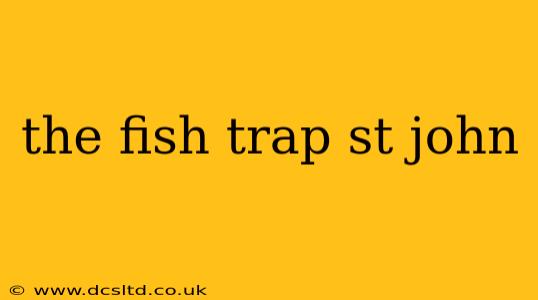The Fish Trap at St. John, U.S. Virgin Islands, is more than just a historical landmark; it's a living testament to the ingenuity of the island's inhabitants and a window into the complex ecological dynamics of the Caribbean. This article explores the history, construction, ecological impact, and modern relevance of this fascinating structure.
What is the Fish Trap at St. John?
The Fish Trap, also known as the Salt Pond Bay Fish Trap, is a unique, centuries-old stone structure located in Salt Pond Bay on St. John. It's a remarkable example of sustainable fishing practices developed by the island's early inhabitants, primarily utilizing natural resources and ingenuity to create a highly effective fishing system. The trap isn't a single structure but a series of carefully placed, interconnected walls built out into the bay, funneling fish into a central holding area.
How does the Fish Trap work?
The Fish Trap's design leverages the natural behavior of fish and the bay's currents. The stone walls, built in a funnel-like shape, guide fish towards a central enclosure. The walls are strategically positioned to take advantage of tidal flows and the fish's tendency to follow the shoreline. As the tide ebbs and flows, the trapped fish are concentrated within the enclosure, making them easier to harvest. This ingenious system allowed for sustainable fishing without depleting fish stocks.
Who built the Fish Trap at St. John?
While the exact origins of the Fish Trap are debated, archaeological evidence suggests its construction predates European colonization, likely built by the island's indigenous peoples. The construction methods and the integration with the natural environment point to generations of knowledge and careful observation of the local ecosystem. The precise timeline remains a subject of ongoing research.
What materials were used to build the Fish Trap?
The Fish Trap's construction primarily utilized locally sourced materials. The walls are built from readily available stones, carefully fitted together to create strong, durable structures resistant to the forces of the ocean. The use of indigenous materials highlights the sustainability and practicality of the design.
What is the ecological impact of the Fish Trap?
The ecological impact of the Fish Trap is a complex issue. While traditionally it facilitated sustainable fishing practices, the modern influence of tourism and other human activities necessitates careful management to minimize any negative impacts. Ongoing research assesses its influence on local fish populations and the overall health of the bay's ecosystem.
Is the Fish Trap still used today?
While not actively used for large-scale fishing as it once was, the Fish Trap remains a valuable historical and cultural resource. It's protected as a part of the Virgin Islands National Park, highlighting its significance. Limited fishing might occur, but its primary function now is as a significant historical site and a focus for education and ecotourism.
How can I visit the Fish Trap?
The Fish Trap is accessible by land and offers stunning views of Salt Pond Bay. Visitors should be aware that it is a fragile historical site and should be treated with respect. Many guided tours incorporate visits to the Fish Trap, providing historical context and information about the surrounding ecosystem. Check with local tour operators and the Virgin Islands National Park for the most up-to-date information.
The Fish Trap at St. John offers a unique blend of history, ecology, and cultural significance. Its continued preservation is essential, ensuring that future generations can appreciate this remarkable example of sustainable ingenuity and its profound connection to the island's past.
